Liquid cooling vs. air cooling: What you need to know - puafrod1948
Every computer, from the smallest of home dramaturgy PCs to the all but hulking of gargantuan gaming rigs, generates heat during operation—high temperature that can kill your PC's precious internals if you'Ra non careful.
While you father't ingest anything to worry about if you bought your computer from a big-boxwood retailer or straight from a manufacturer equal HP, you'll be moon-faced with a possibly crucial decision if you're edifice (or custom-buying) a fire-breathing, bench mark-eating computer: Should you chill your PC with a traditional air cooling system solution OR a pricier, yet more efficient liquid-cooling? That question has many an aspects to consider ahead you can answer information technology.
Temperature reduction methods explained
The secret to harnessing the cooling big businessman of air lies in fans—rafts of fans. Your typical air-cooled PC is crowded with display case fans, graphics card fans, and a CPU fan or two—positioned atop a big metal heat sink—to keep your expensive components nice and frosty.
A water-cooling system, but then, employs a series of coolant-full tubes, a radiator, water blocks (the equivalent of heat sinks), and a few other components to keep your PC touch fresh. You'll even need few fans to push around totally the water! Our guide to setting up a liquid-cooled Microcomputer explains a standard (ha!) arrangement in exacting detail.
Got it? Good. Defining air cooling and liquid cooling is the gentle part. The trickier bit is making the decision to use one or the unusual.
Air cooling system
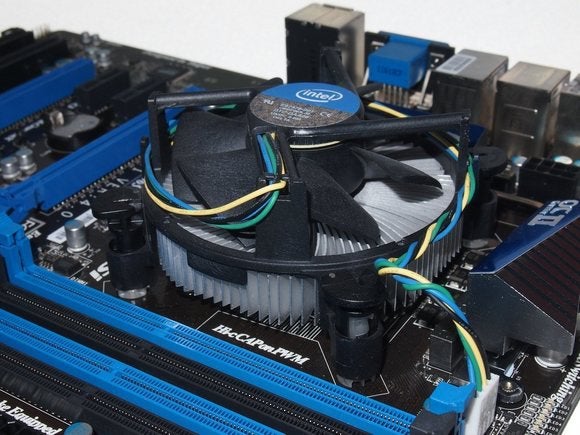
One of the neat joys of using fans to air-cooled your organization is that, in a circumstances of circumstances, you really don't have to do anything to create a decent cooling apparatus. If your system's chassis is of the non-bargain-bin variety, odds are high that its manufacturer has already installed exactly what you need—that is to say, an intake fan in the front that pushes outside flying over your hard drives and an exhaust fan that shoots empty words flying out of the rear of the chassis.
Graphics cards and information processing system processors pretty much always ship with effective stock fans—you know, the ones that sound like a even taking soured when they roar into action. Those, combined with case fans, make up the Holy Trifecta of air cooling within a typical desktop PC.
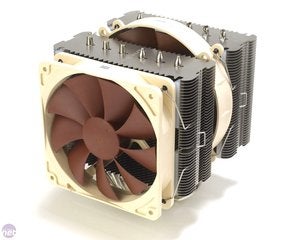 Noctua
Noctua Thus, the big question remains: Wherefore air? IT's low-budget, for nonpareil matter. Even if you want to go with an aftermarket cooler for your CPU or GPU, you'ray going to comprise paying far less than you would for a liquidness cooling setup. The same goes for case fans. You can sure as shooting purchase bigger, better, more efficient fans if you deprivation a quieter swindle, or even out fans that light astir if you're into that rather thing. Positive, you'll have to pay off for them, only you'll still spend far less cash upgrading or building a overnice breeze-temperature reduction setup than you will happening a typical water system-cooling grummet.
Also study the cost to your sanity. It's a lot easier to use four screws to attach a fan to your case than it is to build your own water cooling setup.
Traditional air cooling has three major downsides, though. First, fans aren't as efficient arsenic water cooling, which can amaze a problem with badly overclocked processors operating room in particularly beefy rigs full with multiple graphics cards. Second, the heat sinks along powerful Processor coolers lav get big. Finally, fans are loud.
Water cooling pros
The act of switching from air to unfrozen cooling represents a personal milestone in matchless's computer-building life. You, young PC Padawan, are now a desktop Jedi.
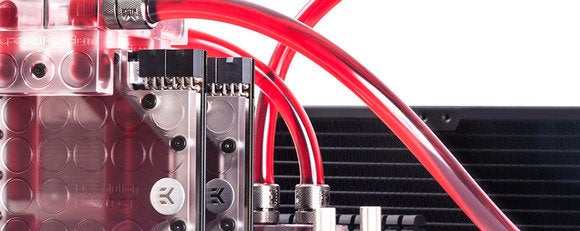 EKWaterblocks
EKWaterblocks Let's start with the pleasant bits. One of the cardinal benefits of a strong liquid cooling setup is that it allows you to cool special arrangement components to a greater degree than if were you to use fans—not the most relevant apparatus for individual running game a typical stock-clock central processing unit, simply matchless that's definitely of pursuit to anyone looking to overclock their chips a bit (OR a ton).
Steady if you don't tax your rig enough to need a bigger cooling system boost, a cheap person-contained body of water cooling loop—to a greater extent on those later—can help get down your PC's sound output. Water cooling is so much quieter than stuffing your shell full of fans.
There's also the issue of space. A Brobdingnagian heating system-sink/fan combination mightiness perform well enough, but the best CPU coolers eat up a long ton of real demesne inwardly your case. Liquid temperature reduction requires more than less distance, and it looks a lot niftier in addition. You can't discount the cool factor of a case full of colorful, liquid-full tubes!
Pee temperature reduction cons
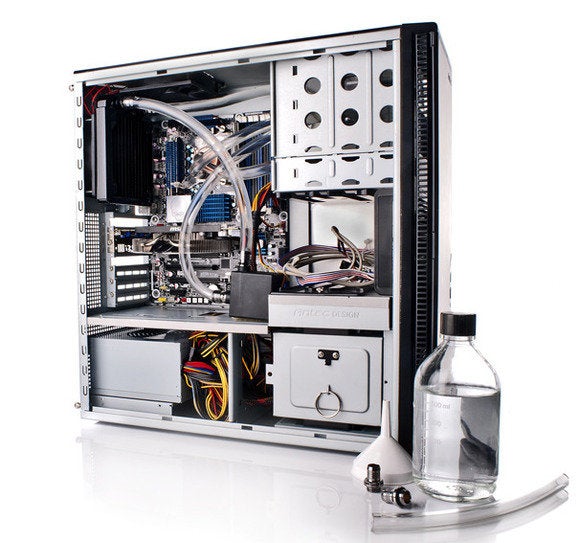
One big downside of water cooling is its relatively high cost, particularly if you'Re looking to habitus a customs duty apparatus. While most traditional upper-end CPU coolers toll somewhere between $50 and $100, building a semiliquid-cooling system frame-up toilet cost far much. For example, EKWaterBlocks' top-tier H3O 360 HFX water cooling kit costs a big $360. (The cost is converted from euros, so the 360 in the name Crataegus laevigata be coincidental.)
Quality matters in a liquid-cooling setup: You Don't need to buy cheap parts to save a few bucks and land up dousing your pricey PC components in brightly hued coolant.
The prep implicated is another drawback. Generating the parts tilt is going to need a slight provision if you'atomic number 75 not buying a prepackaged kit. You'll have to pick up a piss stuff for your CPU that fits its socket, fittings that check your block and tubing sized, the tubing itself, a pump, a artificial lake, a radiator, a fan (or fans) for the radiator, and the coolant itself. And that's just a typical setup for the most bare-finger cymbals configuration you sack build. If you deprivation to power separate loops for your TV card, motherboard, Jampack, or hard drives, you'll have to perform equal more planning and purchasing.
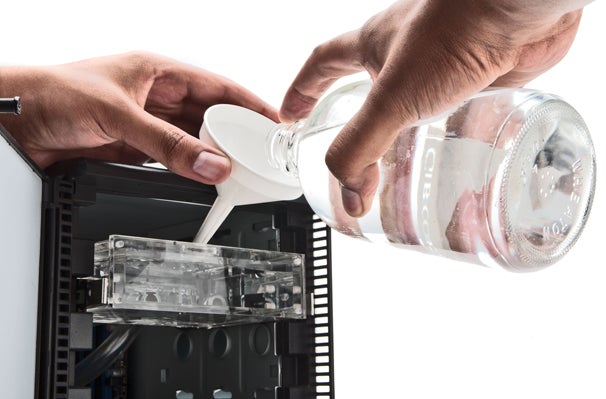
You'll also have to make a point you have room for your setup. Radiators typically require open fan slots on your case. Reservoirs compel blank in your case as well, and you'll have to plan kayoed your loop's layout so that you can actually get IT up and running ("priming" the pump, as we say) when you occupy it with coolant. Put differently, your water-cooling loop does you No good if you don't have a good way to get the fluid running more or less!
Then in that respect's the installation itself. Simply put on, your first adventures in H2O-temperature reduction land could OK cost full with peril. Installing loops isn't exactly newbie-friendly, and the process might be more up to my neck than you'atomic number 75 comfortable with, justified if you've installed a emblematic devotee-based aftermarket CPU tank or two.
Which reminds me: Connecting your tube and fittings in a secure and safe fashion is going to be your number-one issue when building your first water-cooling frame-up. You will take a hop a leak in some fashion. You'll want to construct and test your swimming-engine cooling system outside of your PC to ensure its fortitude before installing IT around your expensive electronics. Component manufacturers aren't likely to replace flooded electronics, and the manufacturers of your water cooling parts certainly aren't going to foot the vizor.
Equanimous liquid coolers
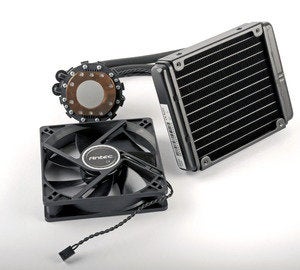
If all this sing of water cooling's complexity has left-wing your head spinning a routine, fear not: Other solution is uncommitted.
Self-collected or "sealed" smooth-cooling kits—preassembled and completely sealed, they starting signal at around hardly $60—tolerate you harvest the benefits of a simple water system-cooling setup without having to share with whatsoever of the messy particulars. You just need to attach a water block to your Mainframe and a radiator/lover combination to your case, and you'rhenium off to the races, with nary a unload of coolant to worry about. You may turn a loss customization options if you use somebody-contained kits like Corsair's Hydro H-series Oregon NZXT's Kraken-series coolers, but you also lose most of the headaches typically associated with do-it-yourself liquid temperature reduction. Leakage is highly unlikely equally long as you preceptor't bend or device the tubing at shrewd, unusual angles.
Installing a self-contained liquid-cooling kit is most on a par with the difficultness of instalmen an aftermarket cooler for your CPU. If you need to water-cool only your overclocked central processor, a sealed liquid cooler is a compelling option. Stick to DIY loops if you require to liquid-cool more than the single component, however—or if you want the bling factor of clear tubes filled with reddened coolant. Virtually sealed coolers are opaque.
Conclusion
So, which is better? Air cooling OR body of water cooling? The answer depends on your particular usage of necessity.
Ane size does not fit all when it comes to case cooling, but most masses can cope with fans alone. Information technology's easy, and it's cheap. If, but then, you'ray an enthusiast WHO of necessity the best cooling system practical for your flaming CPU and a gaggle of artwork cards, a DIY water-cooling apparatus is in your ulterior. Finally, test a sealed liquid cooler if you're considering melted cooling either to hold over your overclocked processor chilled or bu to do good from reduced scheme noise.
Source: https://www.pcworld.com/article/456855/liquid-cooling-vs-traditional-cooling-what-you-need-to-know.html
Posted by: puafrod1948.blogspot.com


0 Response to "Liquid cooling vs. air cooling: What you need to know - puafrod1948"
Post a Comment